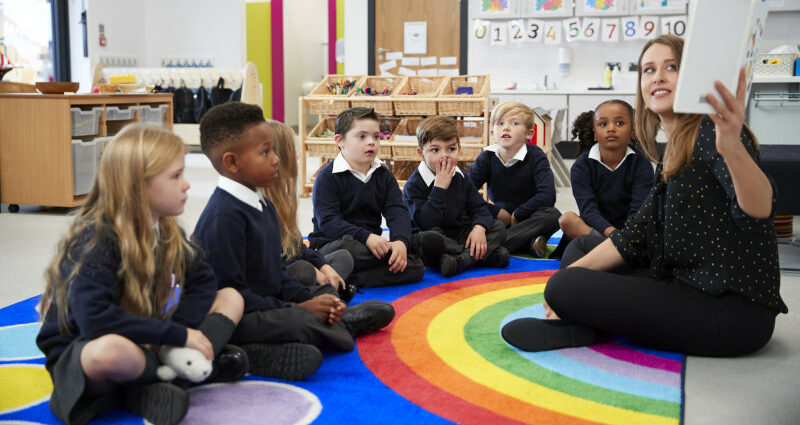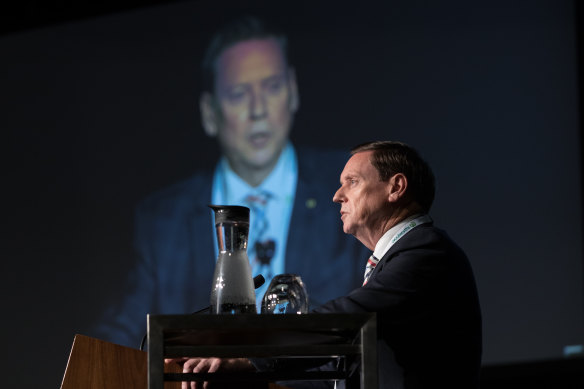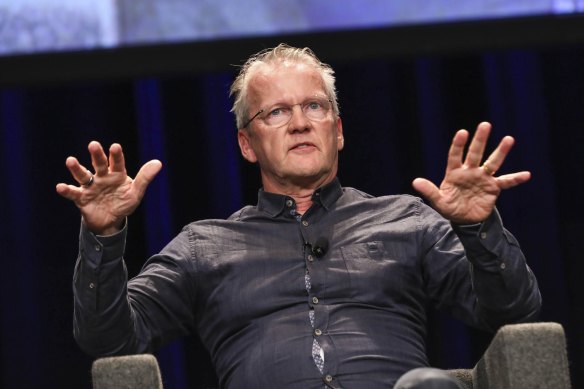Save articles for later
Add articles to your saved list and come back to them any time.
School students would progress through levels similar to music lessons or video games, rather than aged-based grades, under an overhaul of education aimed at moving away from the “conveyor belt” model that can leave many students behind.
Professor Geoff Masters, chief executive officer of the internationally recognised Australian Council for Educational Research, has proposed a revision of schooling, saying the system is stuck in a 19th-century, assembly-line model that pushes students through grades at a fixed pace without considering their individual proficiency.
Professor Geoff Masters in 2020.Credit: Janie Barrett
Masters, who led a review of the NSW curriculum in 2020, said there could be up to six years’ difference in the levels of knowledge in each class, which was impossible for many teachers to manage.
He said the current system was beholden to an overloaded curriculum that dictated what children would learn according to their age, rather than their readiness, then automatically pushed them to the next stage at the end of each year.
“The consequence … is that students who don’t master content in the time that’s given often lack the prerequisites for what comes next,” he said.
More than a quarter of the nation’s year 9 students were performing below expected proficiency in this year’s NAPLAN test. For writing and grammar, it was higher than 40 per cent.
The results of the latest Programme for International Student Assessment (PISA) shows the average 15-year-old Australian student was 3½ years behind the average Chinese student who sat the test.
Masters said the best predictor of where students would be at year 9 was where they were at an earlier age. He said the key to helping children learn was early intervention, then constant monitoring to assess their progress.
“I think part of the problem has been that we haven’t done that as well as we could,” Masters said.
“Kids get to year 9 or year 10, and they’re still reading at the level of a year 5 student … and that’s because skill gaps have emerged and not been adequately addressed, because we’ve had to move on and teach you the next curriculum, even though you might not be ready for it anyway.
“We’re on this kind of conveyor belt that’s moving at a fixed rate.”
Education Minister Jason Clare said catch-up tutoring could help students learn as much over 18 weeks as they could in a year. On Tuesday, Victoria announced it would spend $485 million to extend its tutoring program for the next two years.
Victorian Education Minister Natalie Hutchins said schools used differentiated teaching methods to extend the knowledge and skills of every student in every class, “regardless of their starting point”.
But in the latest Attitudes to School survey, obtained by The Age under freedom of information laws, only 65 per cent of students said they were receiving differentiated lessons last year, down 5 per cent from 2020.
Masters said school tutoring programs had addressed the problem to some extent, but the entire schooling model needed examining.
“Think about what happens in music, for example, where you can be at grade four piano whether you’re six years old or 86 years old, because grade four piano means something in an absolute sense,” he said.
“I’m not suggesting that we’d suddenly have a 15-year-old sitting down with an eight-year-old. What I am saying is that we need to better recognise the variability that currently exists within year levels. And we need to do more, not just push it back on to teachers and say you solve the problem. We need more systemic responses to that reality.”
University of Melbourne Professor Pasi Sahlberg said Masters pointed to a real problem that should be addressed, but the underachievement was amplified by NAPLAN’s design, which created inappropriate expectations of grade-based performances.
Pasi Sahlberg says the design of NAPLAN created inappropriate expectations of grade-based performances.Credit: Dominic Lorrimer
Sahlberg said high schools in Finland were already based on a non-graded structure, but implementing this in Australia would require a new curriculum architecture, a different view of assessments and more responsibility from students for their own learning.
Eliminating the growing number of students performing below proficiency would also not occur without addressing socio-educational disadvantage, he said.
“Whatever the solution to this systemic problem of inadequate student performance in our schools is, it should be carefully tested in practice,” he said. “All ‘treatments’ to educational dysfunctions come with unintended consequences that may only make things worse.”
Dr Paul Kidson, senior lecturer in educational leadership at the Australian Catholic University, said the notion of levels-based learning would be supported by some teachers, particularly in subjects such as maths, where students needed foundational knowledge to underpin their learning.
But the practicality of how to group students was more challenging, considering timetables and the “assumed normalcy” that all students would progress together.
Kidson said decluttering the curriculum and relieving teachers of administrative work would free more time to tailor lessons to different skill levels.
Tina King from the Australian Principals Federation said the curriculum provides a framework of what to teach, but the focus needed to be on how to teach it.
“Aged-based education can lead to gaps in knowledge, particularly when some students are not developmentally ready for certain topics and skills,” she said.
Get the day’s breaking news, entertainment ideas and a long read to enjoy. Sign up to receive our Evening Edition newsletter here.
Most Viewed in National
From our partners
Source: Read Full Article
-
UK’s spookiest location is haunted by ‘black-eyed’ girl lurking in woods
-
Former Royal Marine sues over 'hearing loss' from 'useless' earplugs
-
James Webb offers new perspective on something closer to home: Jupiter
-
Terrifying moment thugs brandish guns as little boy desperately runs for safety | The Sun
-
Brits to face 60mph winds and downpours before 21C blast



